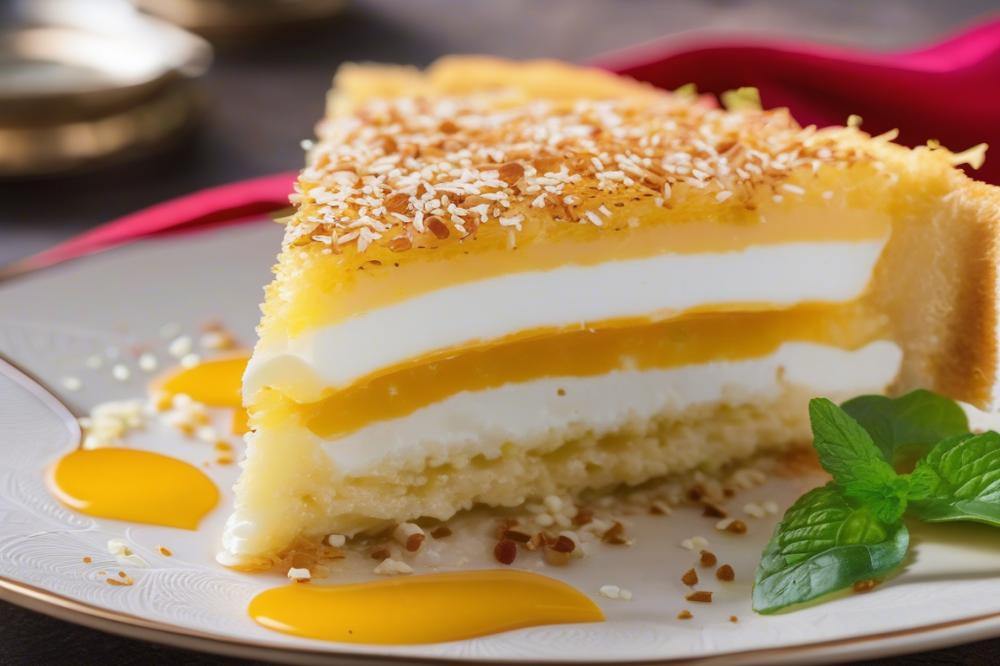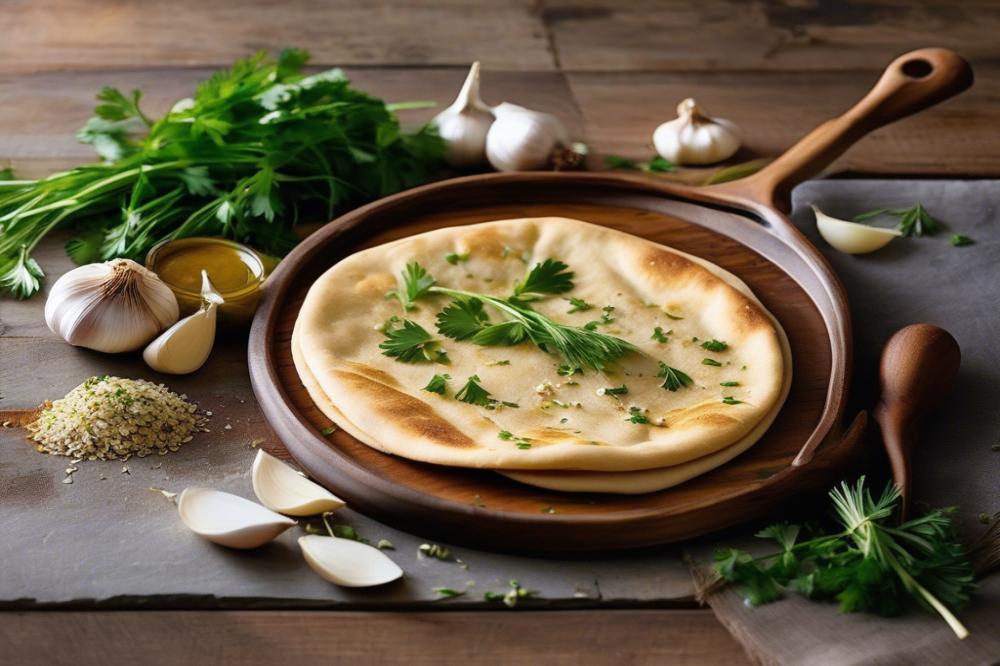Introduction
When you think about Middle Eastern sweets, one dish often stands out: Lebanese Knafeh. This delightful pastry has a special place in the hearts and stomachs of many. Knafeh is not just a dessert; it represents a tradition that has been passed down through generations. With its rich flavors and textures, this dish captures the essence of a festive gathering.
Cheese-filled desserts have a unique appeal. The combination of sweet and savory in one bite creates an explosion of taste. A gooey cheese filling complements the crunchy layers of phyllo dough, making it irresistible. Each bite brings comfort, warmth, and a hint of nostalgia.
In Middle Eastern cuisine, Knafeh is more than just a treat; it symbolizes celebration. You might find it served at weddings, birthdays, or other important events. This dessert recipe often draws crowds, each person eager to savor the delightful sweetness topped with aromatic sweet syrup. Such experiences create lasting memories, linking food, family, and culture. Cheese Knafeh not only fulfills the craving for something sweet but also brings people together.
The Tradition of Lebanese Knafeh
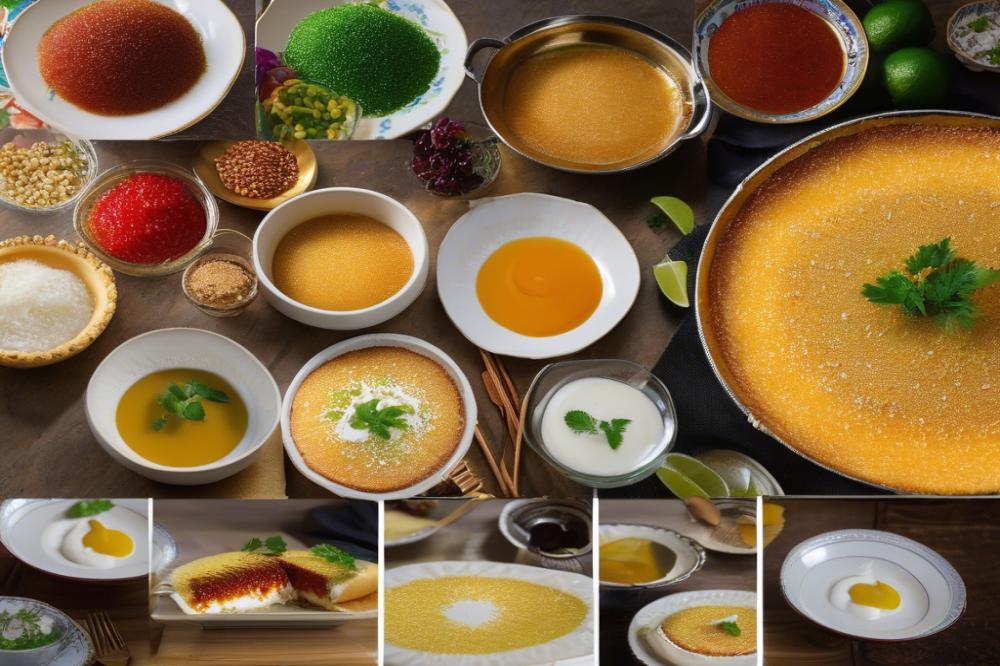
History of Knafeh in Lebanon
Knafeh has deep roots in Lebanese culture. This dessert dates back centuries. It is believed to have originated in the city of Nablus, but Lebanon embraced it wholeheartedly. Traditionally, it is made with layers of phyllo dough and a delicious cheese filling. Over time, variations emerged across the region. Today, it is a staple in many Lebanese households.
Significance in Cultural Celebrations and Events
Lebanese Knafeh holds a special place during celebrations. Families prepare it for parties, weddings, and religious holidays. Sharing this dessert symbolizes hospitality. People gather to enjoy its rich flavors, further strengthening bonds. Each bite of this traditional dessert brings joy and nostalgia. Festivals often feature kunafa as a highlight, showing its importance.
Differences Between Regional Variations
While Knafeh is enjoyed throughout the Middle East, differences exist. Some regions use semolina instead of phyllo dough, creating a unique texture. The cheese filling might vary too. In some areas, people prefer a sweeter taste by adding more sugar or a thicker layer of sweet syrup. These variations reflect local preferences and ingredients. No matter where it’s made, every version of this pastry carries the essence of tradition.
Ingredients and Quantities
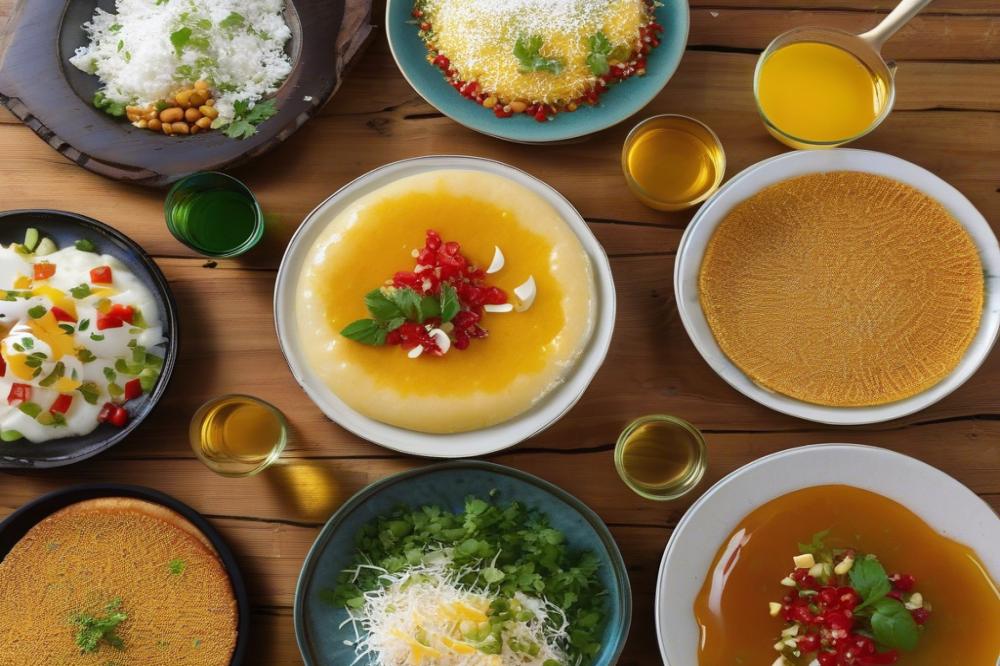
To create the delightful Lebanese Knafeh with cheese, you’ll need several key ingredients that come together beautifully. This traditional dessert is known for its rich flavors and delicious layers.
List of Ingredients
- Phyllo dough
- Akkawi or mozzarella cheese
- Sugar
- Butter
- Water
- Rose water or orange blossom water
- Pistachios (for garnish)
Quantities for Each Ingredient
The following quantities will help you prepare this sweet pastry:
- Phyllo dough: 500 grams, lightly brushed with melted butter to create a crisp layer.
- Akkawi or mozzarella cheese: 400 grams, shredded or sliced, providing a gooey cheese filling that melts perfectly.
- Sugar: 200 grams, for sweetness in both the filling and the syrup.
- Butter: 150 grams, melted, essential for achieving a rich flavor and golden color.
- Water: 250 ml, to dissolve the sugar and make the sweet syrup.
- Rose water or orange blossom water: 2 tablespoons, adding a fragrant essence that enhances the dessert recipe.
- Pistachios: 100 grams, crushed, for a beautiful and crunchy garnish on top.
Nutritional Information
Understanding the nutritional content of each ingredient helps in crafting the perfect treat. Here’s a breakdown:
- Phyllo dough: Low in calories but may contain some fat; it’s primarily carbs.
- Akkawi or mozzarella cheese: A good source of protein, calcium, and fat; helps create the creamy texture.
- Sugar: High in calories; provides the sweetness needed for Middle Eastern sweets.
- Butter: Adds richness but is high in saturated fat and calories.
- Water: Calorie-free; essential for syrup-making and hydration.
- Rose water or orange blossom water: Very low in calories; its flavor is concentrated and aromatic.
- Pistachios: A healthy nut option providing healthy fats, protein, and essential vitamins.
Method: Making Lebanese Knafeh
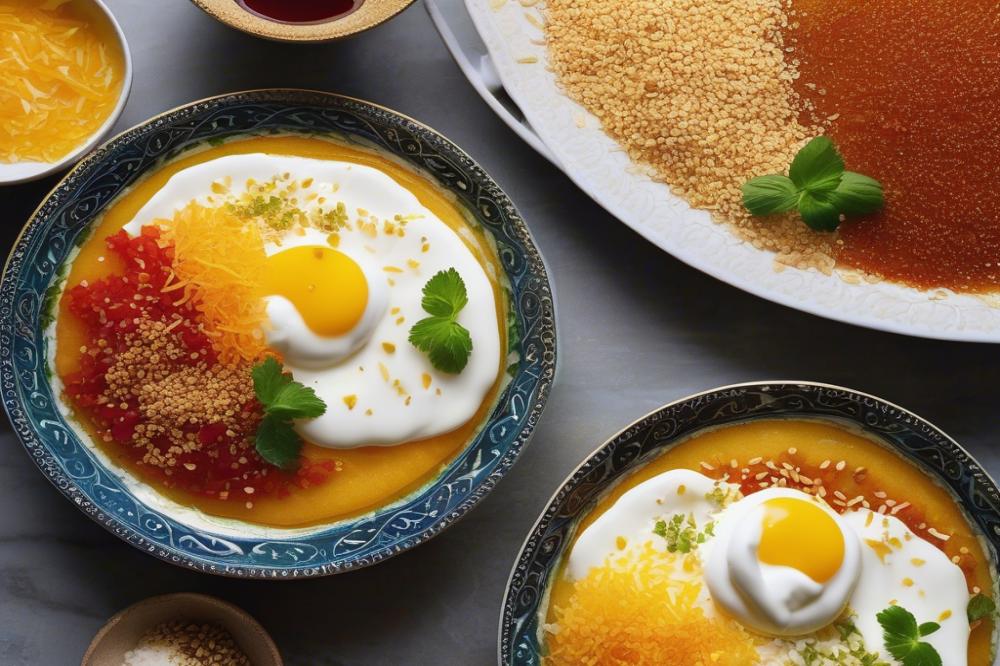
Preparing the Phyllo Dough
Start by gathering all necessary ingredients for the pastry. Phyllo dough is usually sold in packages, found in the freezer section of grocery stores. Once you have the dough, carefully unwrap it and lay it on a flat surface. Cover the sheets with a damp cloth to prevent them from drying out. Take one sheet and brush it lightly with melted butter. Repeat this process with several layers, stacking them one on top of the other. A good base will give the dessert richness and a perfect crunch.
Creating the Cheese Filling
Next, you need to prepare the filling. For this step, combine cheeses like mozzarella and akawi. Soak the akawi cheese in water for a few hours to reduce saltiness, then drain and shred it. Mix the cheeses together in a bowl, creating a smooth and creamy consistency. Add a little bit of sugar and a splash of rosewater to enhance the flavor. This cheese filling provides a delightful surprise that contrasts beautifully with the sweet syrup later on.
Assembling the Dessert
In a large baking dish, layer the prepared phyllo dough at the bottom. Spread half of the pastry evenly, ensuring coverage over the bottom. Sprinkle the cheese filling generously on top of the base. Then, layer the remaining phyllo sheets over the cheese. Brush the top layer with more melted butter, sealing the delicious ingredients inside. Use a sharp knife to score the surface into squares before baking. Scoring helps with even cooking and easy serving afterward.
Baking Process
Preheat your oven to a moderate temperature, around 350°F (175°C). Place the assembled pastry into the oven and bake it for about 30 to 40 minutes. The top should turn a lovely golden brown, resembling a perfect traditional dessert. Keep an eye on the baking process. The smell of rich flavors will fill your kitchen, making it hard to resist.
Preparing and Adding the Sweet Syrup
While the pastry bakes, create the sweet syrup. Combine sugar and water in a saucepan over medium heat. Stir until the sugar dissolves completely. After that, add a slice of lemon for a touch of acidity and allow it to simmer for about 10 minutes. Once ready, remove it from heat and mix in a splash of rosewater for fragrance. When the kunafa is fully baked, pour the sweet syrup over it. Let it soak in for a few moments. This final touch transforms the dish into a fabulous example of Middle Eastern sweets.
Serving and Presentation
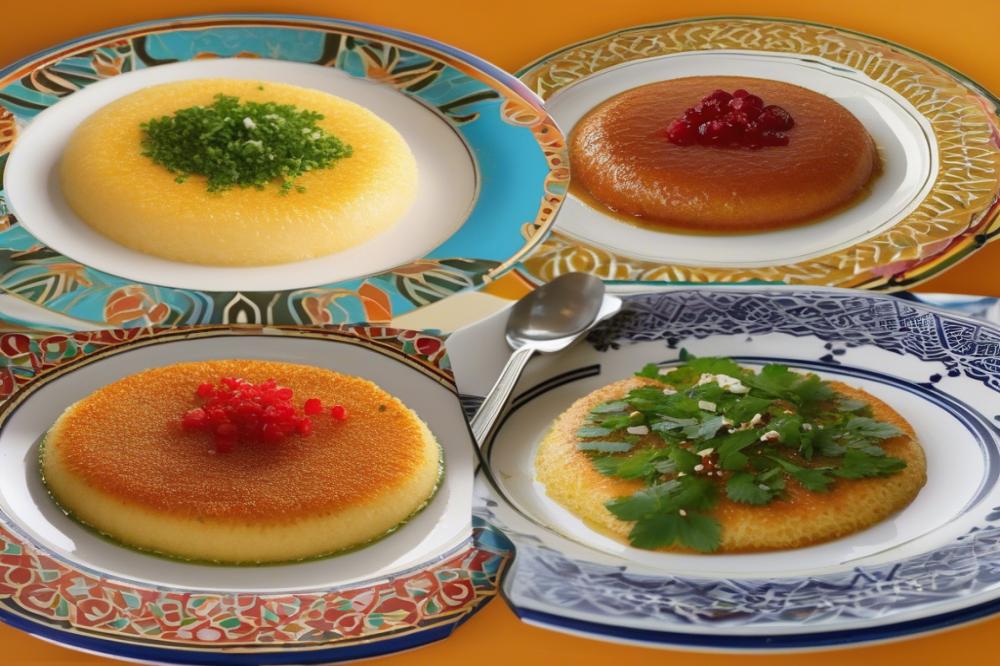
Traditional Ways to Serve Knafeh
Lebanese Knafeh is often served warm, straight from the oven, to highlight its deliciously gooey cheese filling. A large, round tray is traditional, making it easy for guests to share. Cut the pastry into generous squares or wedges before serving. A classic practice involves offering each piece with a drizzle of sweet syrup over the top. This addition enhances the rich flavors and creates a delightful blending of textures. Some also serve it on smaller plates as a personal dessert, inviting diners to enjoy it leisurely.
Recommended Accompaniments
Pairing is an essential part of the experience. Many people enjoy knafeh alongside a cup of strong Arabic coffee; its bitterness balances the sweetness of the dessert. Herbal teas often accompany it as well, providing a refreshing contrast. Consider offering a side dish of whipped cream or a scoop of vanilla ice cream to add a creaminess that complements the pastry. Fresh fruits, such as strawberries or oranges, can also make a bright addition to the plate. These enhancements will bring out the unique characteristics of the dish.
Tips for Presentation and Garnishing
When it comes to garnishing, a sprinkle of crushed pistachios on top adds both color and crunch. For a touch of elegance, consider using edible flowers or mint leaves as a decorative element. Their vibrant hues brighten the presentation and make it more visually appealing. Drizzling extra sweet syrup in an artistic manner around the plate can elevate the dish even further. Ensure that the pieces look inviting and appetizing. Using a contrasting plate can help the colors pop. The right presentation makes the entire dessert recipe feel more special.
Flavor Profile and Variations
Knafeh is known for its rich flavors that dance on the palate. This delightful dessert features layers of crispy phyllo dough, combined with a sweet cheese filling. Traditionally, a sweet syrup is drizzled over the top, soaking into the pastry and creating a beautiful balance of sweetness and texture. The combination of warm, gooey cheese and crunchy layers makes each bite a delightful experience. Each element contributes to a complex flavor that embodies a celebration of textures and tastes.
Flavoring the syrup can add a twist to the classic dish. Some opt for a hint of rosewater, which brings a floral quality to the sweetness. Others might prefer orange blossom water, lending a citrus note that brightens the overall taste. Cinnamon or cardamom can also be infused into the syrup, providing warm spices that complement the sweetness beautifully. These variations can turn a simple dessert recipe into something more exciting and unique.
Exploring various toppings introduces more complexity. Adding finely chopped nuts like pistachios or walnuts creates a satisfying crunch. Some enjoy almond or hazelnut slivers for a different texture. Another option is to incorporate additional fillings within the kunafa layers. Ground pistachios or a layer of chocolate spread also elevate this traditional dessert. The diversity of toppings and fillings offers countless combinations, making every bite an adventure.
Final Thoughts on a Culinary Treasure
Lebanese Knafeh is more than just a pastry; it represents a rich tradition and a deep connection to the culture of Lebanon. This delicious dessert is known for its charming layers, melted cheese, and sweet syrup that delight the palate, making it a favorite among many. Enjoying this treat often brings back memories of family gatherings and festive occasions, highlighting its significance in social celebrations.
Trying your hand at making this unique dessert can be a rewarding experience. With a little patience and practice, anyone can recreate this beloved dish in their own kitchen. Experimenting with different cheeses and flavors can add a personal touch to your version of knafeh. So, gather your ingredients, roll up your sleeves, and embark on this culinary adventure. It promises to be a deliciously fun task!
Exploring other Lebanese dessert recipes will deepen your appreciation for this vibrant cuisine. Each item has its charm, whether it be baklava or maamoul. Engaging with these delightful recipes can transport you to another world full of flavors and aromas. Ultimately, food has a wonderful way of connecting people to their roots and to one another.

